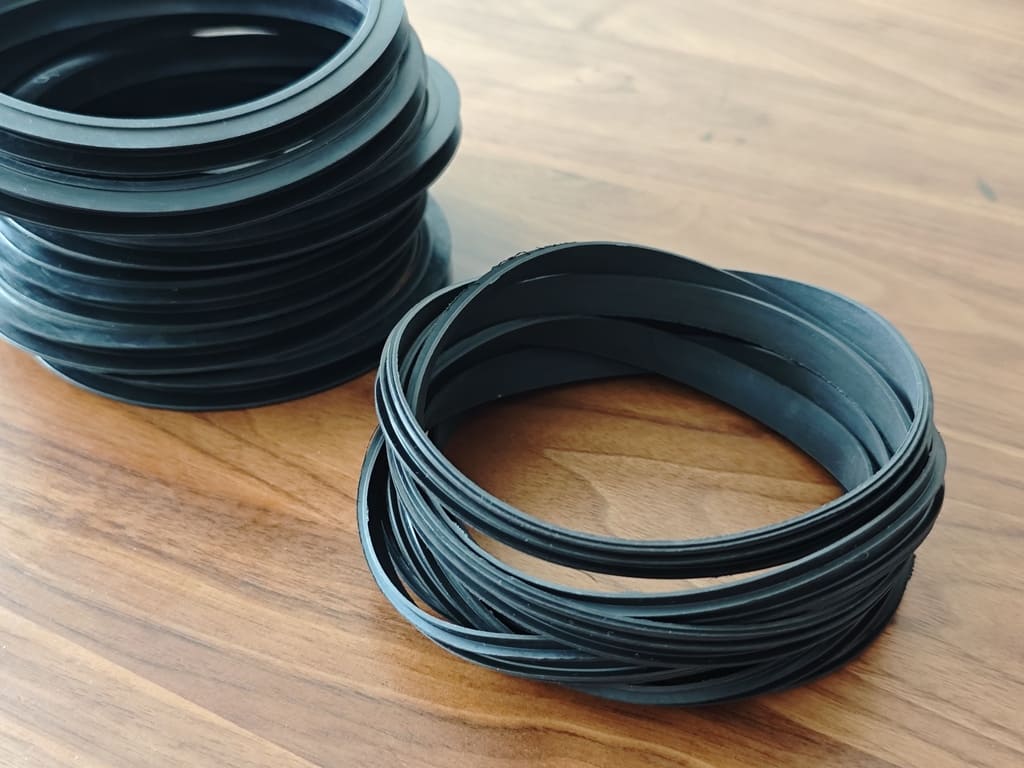Introduction to Rubber Gaskets in HVAC Systems
Rubber gaskets are integral to HVAC systems, providing essential sealing to prevent air leakage, enhance energy efficiency, and protect internal components. These seemingly small components play a critical role in ensuring the system’s optimal performance and longevity, especially as HVAC systems are subject to significant environmental stress.
What is a Rubber Gasket?

A rubber gasket is a seal formed from rubber material, strategically placed between two surfaces to prevent leakage. In HVAC systems, rubber gaskets are used to seal air ducts, compressor systems, and other components, creating an airtight enclosure that is crucial for temperature regulation and energy efficiency.
Why Rubber is an Optimal Material for HVAC Gaskets
Rubber’s flexibility, resilience, and durability make it ideal for gasket applications in HVAC systems. The material adapts to the metal and plastic surfaces within HVAC units, compressing to fill small irregularities and providing a firm seal that withstands both high and low temperatures.
Types of Rubber Materials Used in HVAC Gaskets
- Neoprene
- Properties: Good resistance to compression set, oil, and weathering.
- Applications: Commonly used in indoor HVAC applications due to its flexibility and durability.
- Advantages: Cost-effective and versatile; suitable for a wide range of temperatures.
- EPDM (Ethylene Propylene Diene Monomer)
- Properties: Excellent resistance to UV light, ozone, and extreme temperatures.
- Applications: Ideal for outdoor applications where exposure to sunlight and weather is a concern.
- Advantages: Long-lasting performance in harsh environments; maintains flexibility at low temperatures.
- Silicone
- Properties: High-temperature resistance and excellent flexibility.
- Applications: Suitable for high-temperature HVAC applications, such as around furnaces or heat exchangers.
- Advantages: Non-reactive and stable under extreme conditions; ideal for applications requiring high thermal resistance.
- TPE (Thermoplastic Elastomers)
- Properties: Combines the properties of rubber with the recyclability of plastics.
- Applications: Used in various HVAC components due to its adaptability.
- Advantages: Easy to process and mold; provides good sealing capabilities.
Key Considerations for Material Selection
- Environmental Factors: Outdoor gaskets must withstand UV radiation, moisture, and temperature fluctuations. EPDM is often preferred in these scenarios due to its robust weathering properties.
- Temperature Resistance: Silicone gaskets excel in high-temperature environments but may be over-engineered for applications that do not require such extremes.
- Sealing Effectiveness: Closed-cell materials can provide superior sealing by preventing air and moisture penetration but may require higher closing forces.
Comparison of Gasket Materials
| Material | Temperature Range | UV Resistance | Compression Set Resistance | Cost |
|---|---|---|---|---|
| Neoprene | -40°F to 212°F | Moderate | Good | Low |
| EPDM | -60°F to 300°F | Excellent | Excellent | Moderate |
| Silicone | -100°F to 500°F | Excellent | Good | High |
| TPE | -40°F to 200°F | Moderate | Fair | Moderate |
Key Functions of Rubber Gaskets in HVAC Systems
Rubber gaskets in HVAC systems serve multiple critical functions, including:
Thermal Expansion Accommodation: They allow for dimensional changes in metal ducting due to temperature fluctuations, maintaining a leak-tight seal.
Sealing: They create airtight seals around access panels, doors, and duct connections, ensuring that heated or cooled air does not escape the system.
Vibration Dampening: Rubber gaskets absorb vibrations from fans and motors, minimizing noise and enhancing comfort within buildings.
Importance of Sealing in HVAC Systems
Effective sealing is crucial for HVAC efficiency, as air leaks can lead to significant energy loss. Rubber gaskets serve as a protective barrier that ensures maximum airflow through ducts and prevents conditioned air from escaping the system, reducing operating costs and enhancing indoor air quality.
Advantages of Using Rubber Gaskets in HVAC Applications
Rubber gaskets offer numerous benefits, including flexibility, resistance to environmental stressors, and the ability to seal tightly even under fluctuating pressure. Their adaptability to diverse HVAC components makes them an invaluable solution for maintaining system integrity and performance.
Design Considerations for HVAC Rubber Gaskets
When designing rubber gaskets for HVAC systems, engineers consider the gasket’s ability to withstand various temperatures, pressures, and chemical exposures. Gaskets must also conform to the surfaces they seal, necessitating precise dimensions and material specifications.
Size and Shape Customization of Rubber Gaskets for HVAC
Customizing gasket size and shape ensures an airtight fit within HVAC assemblies. This customization prevents misalignment that could compromise the seal, allowing the gasket to perform effectively under operational stresses.
Temperature Resistance of Rubber Gaskets in HVAC
HVAC systems experience substantial temperature fluctuations, necessitating gaskets that remain pliable and durable. Rubber gaskets, particularly those made of silicone and EPDM, exhibit high resistance to extreme temperatures, preventing cracking or deformation.
Chemical Resistance Requirements for HVAC Gaskets
Exposure to cleaning agents, refrigerants, and other chemicals within HVAC units requires that gaskets resist chemical degradation. This chemical resilience is particularly important in industrial settings where HVAC systems encounter harsh substances.
Durability and Longevity of Rubber Gaskets in HVAC Systems
High-quality rubber gaskets are engineered to endure the demands of HVAC systems, offering long service life even under continuous stress. This durability reduces the frequency of replacement, saving on maintenance costs and minimizing system downtime.
Installation Process of Rubber Gaskets in HVAC Units
Proper installation of rubber gaskets ensures a secure fit and enhances performance. HVAC technicians use specific methods, including careful alignment and compression testing, to confirm that the gasket provides an effective seal without gaps or misalignment.
Common Issues and Challenges with Rubber Gaskets in HVAC
HVAC rubber gaskets can face issues such as shrinkage, hardening, or tearing over time, often caused by prolonged exposure to extreme conditions. These issues can compromise the gasket’s effectiveness and lead to system inefficiency or failure.
Maintenance of Rubber Gaskets in HVAC Systems
Regular maintenance, including inspections for wear, cleaning, and lubrication (where applicable), extends the life of rubber gaskets. Preventive maintenance helps identify early signs of deterioration, preventing costly system repairs.
Signs of Wear and Replacement Timing for HVAC Rubber Gaskets
Visible signs of wear on rubber gaskets, such as cracks, discoloration, or flattening, signal the need for replacement. Regular inspection schedules help detect these signs early, ensuring continuous performance and preventing system inefficiency.
Comparing Rubber Gaskets to Other Gasket Materials for HVAC
Rubber gaskets provide unique advantages over alternatives like cork, foam, and metal, which may lack the flexibility, temperature resilience, or sealing strength that rubber offers, especially in dynamic HVAC environments.
Sustainability and Environmental Impact of Rubber Gaskets
Rubber gaskets have a moderate environmental footprint, though many manufacturers now use recyclable or biodegradable materials to reduce environmental impact. Sustainable sourcing and production methods contribute to eco-friendly HVAC solutions.
Cost-Benefit Analysis of Rubber Gaskets for HVAC Applications
While rubber gaskets may have a higher upfront cost than simpler materials, their durability and sealing effectiveness offer long-term savings. The extended lifespan and energy efficiency they provide can significantly offset initial investment costs.
Future Innovations in Rubber Gasket Technology for HVAC
Advancements in rubber formulation and manufacturing technology promise enhanced gasket performance. Future developments may focus on increased temperature tolerance, chemical resistance, and eco-friendliness, further improving HVAC system efficiency.
Rubber gaskets are an essential component of HVAC systems, providing an efficient, durable, and adaptable sealing solution. Their ability to withstand environmental stresses and seal tightly ensures the system operates optimally, reduces energy costs, and enhances indoor air quality. As HVAC technology advances, rubber gaskets will continue to evolve, adapting to meet the industry's growing demands for sustainability, durability, and performance.
If you need assistance in selecting the right rubber gaskets for your HVAC system or want more information about our product offerings, contact us today! Our team of experts is ready to help you find the best solutions tailored to your specific needs.








